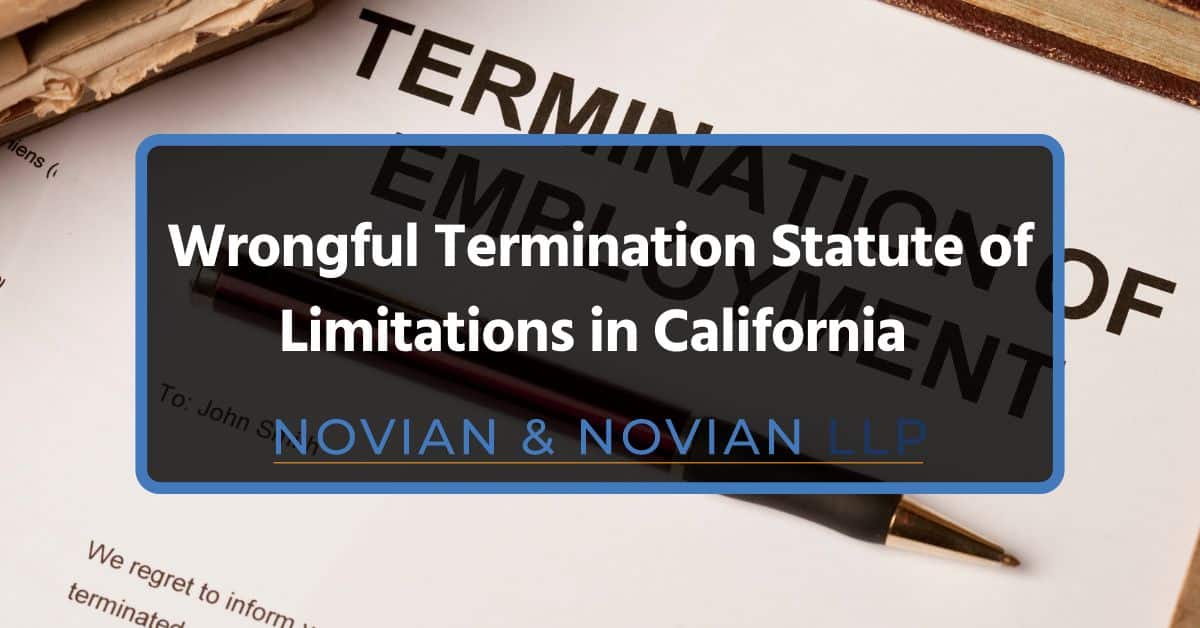
by | Mar 27, 2024 | Employment Law
California statute of limitations laws protect employees from wrongful termination, that is being fired for illegal or wrongful reasons. It means that terminations must not violate federal or state anti-discrimination laws, retaliation laws, or breach the terms of an employment contract.
It is important for employers to understand these laws to ensure that they do not violate public policy. As an employer, understanding these laws helps you manage your employees and lower legal risks effectively.
At Novian & Novian, we have attorneys specializing in employment law who are readily available to offer legal support and advice to employers. We are also experts in dispute resolution with over 35 years of experinece and can provide the necessary guidance to protect your interests. Reach out to us now to get started with a consultation.
In this blog, we will cover everything there is to know about wrongful termination claims.
Is It Hard To Prove Wrongful Termination in California?
No, it isn’t hard to prove wrongful termination in California according to California law. California wrongful termination statute applies to a situation when an employee is wrongfully terminated. For all other cases, it is important to keep in mind that California operates under the at-will employment condition. This means that you have the right as an employer to terminate employees at any time for any reason, as long as it isn’t illegal.
For former employees, there is a specific time frame to sue a former employer when it concerns wrongful termination. The statute of limitations can vary depending on the nature of the claim. For example, claims under the Fair Employment and Housing Act (FEHA) must be filed with the California Civil Rights Department (formerly DFEH) within three years of the alleged wrongful act. After receiving a “Right to Sue” letter, the individual has one year to file a lawsuit in court. It’s essential to be aware of these strict deadlines to ensure legal rights are not forfeited.
The average cost to defend an employment lawsuit varies. It depends on the complexity of the case, length of the case, etc. Some common scenarios that lead to wrongful termination lawsuits include unlawful discrimination or harassment claims, retaliation against employees, non-compliance with contractual obligations, etc. Employers may face an EEOC charge of discrimination when accused of terminating an employee for discriminatory reasons.
The Statute of Limitations for Wrongful Termination Claims
The statute of limitations serves as a deadline for filing claims. It is designed to ensure fairness by preventing the indefinite threat of lawsuits. For employers, this means there is a certain period during which they might face legal action for wrongful termination. For employees, it emphasizes the importance of acting promptly if they believe they have been wrongfully terminated.
The deadlines for filing wrongful termination lawsuits in California vary depending on the nature of the claim. These are categorized primarily under the Fair Employment and Housing Act (FEHA), contractual disputes, and public policy violation claims.
Claims that an employee was terminated in violation of public policy must typically be filed within two years of the dismissal. This includes terminations that go against fundamental public policies of the state, such as firing an employee for refusing to participate in illegal activities.
Employees who believe their termination was due to any of these reasons must first file a complaint with the California Civil Rights Department (formerly known as the Department of Fair Employment and Housing or DFEH) before they can sue their employer. The statute of limitations for filing this administrative complaint is three years from the date of the alleged wrongful termination. Once a Right to Sue notice is issued, the employee has one year to file a lawsuit in court.
For wrongful terminations that involve a breach of an employment contract, the deadlines differ based on the type of contract. For written contracts, the statute of limitations is four years from the date of the breach. If the contract was oral or implied, the employee has two years to file a claim.
For employers, navigating the legal risks associated with wrongful termination lawsuits means maintaining thorough documentation of all employment decisions, especially terminations. It’s also crucial to understand the legal obligations and rights under California law, including the WARN Act for mass layoffs, and provisions related to whistleblower retaliation and discrimination based on protected characteristics.
Implications of the Statute of Limitations for Employers
The statute of limitations gives a timeframe for a former employee to file a claim against their employer for wrongful termination. However, it’s important to note that the timing can sometimes be paused under certain circumstances. This can happen when the claimant is a minor or the defendant lives in a different state. As an employer, it is important to be aware of these exceptions.
You also have a duty as an employer to keep records and documentation. Having these records and documents will serve as evidence when the need arises. It proves that the terminations were for lawful reasons and not illegal. Not only does it aid in legal defense, but it also promotes fairness and transparency in the workplace.
A wrongful termination case ranges between $5,000 to $40,000. It varies depending on lost wages and benefits, emotional distress, legal costs, etc.
Proactive Measures to Prevent Wrongful Termination Claims
Drafting clear employment contracts and policies can help prevent a wrongful termination lawsuit. The employment contracts of your employees should clearly outline the terms of employment, roles, responsibilities, compensation, and expectations.
It is also helpful to have policies that cover all aspects of employment, including anti-discrimination and harassment. It gives your employees a sense of reassurance and safety about the workplace. Curious about how to write up an employee? Our experts at Novian & Novian can give you tips on drafting effective employment policies and contracts.
When you establish clear, consistent disciplinary and termination procedures, ensure that it is applied uniformly to all employees. This transparency helps in demonstrating fairness in actions taken by the employer and can mitigate claims of wrongful termination.
It helps to regularly train management and HR personnel on the legal implications of discrimination, harassment, and retaliation. Furthermore, ensure that all employees are aware of their rights and steps for reporting issues.
Responding to Wrongful Termination Claims: How to Fight Wrongful Termination in California?
Responding to a wrongful termination claim in California requires a strategic and informed approach. As an employer, you must first review the claim carefully to understand the specific allegation being made. Then, you have to compile and gather all relevant documentation related to the employee’s tenure and termination.
Based on the allegation, it is necessary to conduct a thorough internal investigation to gather facts and assess the merit of the claim. Once you review a wrongful termination lawsuit, ensure that you start consulting with your attorney immediately before sending a counterclaim for a frivolous lawsuit.
As you are working with your legal team, you will prepare a formal response to the wrongful termination claim. If the claim involves an administrative complaint to the California Civil Rights Department or another relevant state agency, ensure timely and accurate communication with the agency. Your legal team can assist in managing these interactions and advocating on your behalf.
Resolution strategies for such a lawsuit could be mediation, settlement, or litigation. What matters is that the wrongful termination case is resolved in a fair manner that brings minimum risk to the company.
Exceptions and Special Considerations
The general statute of limitations for wrongful termination claims in California varies based on the nature of the claim. However, there are certain exceptions. For example, the statute of limitations may be paused when the claimant is physically or mentally challenged. It could also be that the employer has concealed their wrongful actions, thereby preventing the claimant from discovering the harm.
Also, in cases of ongoing discrimination or harassment that leads to wrongful termination, the statute of limitations may not begin until the last act of discrimination. Thus, extending the time an employee has to file a claim. In addition, if there is a claim that involves a minor, the time limit may not start until the minor reaches adult age.
Many employers include arbitration clauses in their employment contracts. Thus, requiring employees to resolve disputes through arbitration instead of going to court. However, keep in mind that not all arbitration agreements are enforceable. California law requires such agreements to be fair and not overly burdensome to the employee.
Building a Respectful and Compliant Workplace Culture
To foster a respectful and compliant workplace, you need to carry out comprehensive training sessions, have clear policies and procedures, and maintain an open channel of communication. It also helps to be proactive towards conflict resolution and regularly review employment practices.
As an employer, you have a great role to play in setting the tone for compliance and respect. You must embody the principles of fairness and transparency. This will encourage similar behavior among all employees.
Looking to strengthen your workplace culture and ensure compliance with California’s employment laws? We can help you! Our California employment lawyers, help businesses to implement the best practices.
Whether you’re drafting employment policies, handling a wrongful termination claim, or seeking guidance on compliance issues, Novian & Novian can provide the support and legal expertise you need. Contact us today!
Contact Us
Have questions about this post? Novian & Novian is a full service law firm in Los Angeles with clients that span the country. Contact us today for a free consultation.
Contact Us
Have questions about this post? Novian & Novian is a full service law firm in Los Angeles with clients that span the country. Contact us today for a free consultation.





